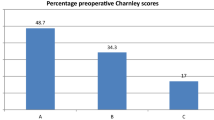Abstract
Ninety-seven patients with 99 total knee arthroplasties were operated on by a surgeon in the first 3 years of his surgical career. Complete survival data were available for all 99 knees. The cases were reviewed at a minimum of 10 years after their initial operation, but as 37 patients had died before reaching 10 years, the average follow-up was 8 years 8 months with a maximum of 12 years 4 months. Ninety-one patients had osteoarthritis, five had rheumatoid arthritis, and three had juvenile chronic arthritis. No patients were lost to follow-up. Four required revision. The 10-year survival rate, using revision for all causes as an end-point, was 94.96%. The survival rate for aseptic loosening was 97.04%. The survival rate for loose joints that had not been revised was 94.13%. Three of the four revisions occurred in the first 6 patients operated upon, suggesting there may be a learning curve for surgeons at this stage in their career.
Résumé
Quatre-vingt-dix-sept patients ayant bénéficié de 99 prothèses totales du genou mises en place par un seul chirurgien lors de ces trois premières années d’activité. Toutes les données ont été récoltées pour ces 99 genoux. Ces patients ont été revus avec un minimum de 10 ans après l’intervention. Trente-sept étaient décédés. Le suivi moyen était de 8 ans 8 mois avec un maximum de 12 ans 4 mois. Quarante-vingt-onze patients avaient été traités pour arthrose, 5 pour arthrite rhumatoïde et 3 pour arthrite rhumatoïde juvénile, maladie de Still-Chauffard. Aucun patient n’a été perdu de vue. Quatre ont nécessité une reprise chirurgicale. Le taux de révision à 10 ans en prenant comme contrôle la révision quelle que soit la cause a été de 94.96%, le taux de survie pour descellement aseptique de 97.04%. Le taux de survie pour les patients qui n’ont pas été repris a été de 94.13%. Trois des quatre révisions sont survenues chez les six premiers patients opérés par le chirurgien et faisaient partie de la courbe d’apprentissage.




Similar content being viewed by others
Explore related subjects
Discover the latest articles and news from researchers in related subjects, suggested using machine learning.References
Armitage P, Berry G (1994) Statistical methods in medical research, 3rd edn. Blackwell Scientific Publications, Oxford
Back DL, Cannon SR, Hilton A, Bankes MJ, Briggs TW (2001) The kinemax total knee arthroplasty. Nine years’ experience. J Bone Joint Surg (Br) 83-B(3):359–363
Emmerson KP, Moran CG, Pinder IM (1996) Survivorship analysis of the kinematic stabilizer total knee replacement: a 10–14 year follow-up. J Bone Joint Surg 78-B:441–445
Ewald FC (1989) The knee society total knee arthroplasty roentgenographic evaluation and scoring system. Clin Orthop 248(9):9–12
Heck DA, Robinson RL, Partridge CM, Lubitz RM, Freund DA (1998) Patient outcomes after knee replacement. Clin Orthop 356:93–110
Hedlundh U, Ahnfelt L, Hybbinette C-H, Weckström J, Fredin H (1996) Surgical experience related to dislocations after total hip arthroplasty. J Bone Joint Surg (Br) 78-B(2):206–209
Jolles BM, Zangger P, Leyvraz P-F (2002) Factors predisposing to dislocation after primary total hip arthroplasty. J Arthroplasty 17(3):282–288
Joshi AB, Gill GS, Smith PL (2003) Outcome in patients lost to follow-up. J Arthroplasty 18(2):149–153
Khaw FM, Kirk LM, Gregg PJ (2001) Survival analysis of cemented press-fit condylar total knee arthroplasty. J Arthroplasty 16(2):161–167
Khaw FM, Kirk LM, Morris RW, Gregg PJ (2002) A randomised, controlled trial of cemented versus cementless press-fit condylar total knee replacement. Ten-year survival analysis. J Bone Joint Surg (Br) 84-B(5):658–666
Li PL, Zamora J, Bentley G (1999) The results at ten years of the insall-Burstein II total knee replacement. Clinical, radiological and survivorship studies. J Bone Joint Surg (Br) 81-B(4):647–653
Liow RW, Murray DW (1997) Which primary total knee replacement? A review of currently available total knee replacements in the United Kingdom. Ann R Coll Surg Eng 79:335–340
Mahaluxmivala J, Bankes MJ, Nicolai P, Aldam CH, Allen PW (2001) The effect of surgical experience on component positioning in 673 press fit condylar posterior cruciate-sacrificing total knee arthroplasties. J Arthroplasty 16(5):635–640
Martin SD, McManus JL, Scott RD, Thornhill TS (1997) Press-fit condylar total knee arthroplasty. Five to 9 year follow-up evaluation. J Arthroplasty 12(6):603–614
Murray DW, Britton AR, Bulstrode CJK (1997) Loss to follow-up matters. J Bone Joint Surg (Br) 79-B(2):254–257
Murray DW, Carr AJ, Bulstrode C (1993) Survival analysis of joint replacements. J Bone Joint Surg (Br) 75-B(5):697–704
Nafei A, Kristensen O, Knudsen HM, Jenson J (1996) Survivorship analysis of cemented total condylar knee arthroplasty: a long-term follow-up report on 348 cases. J Arthroplasty 11(1):7–10
Schai PA, Thornhill TS, Scott RD (1998) Total knee arthroplasty with the PFC system. Results at a minimum of ten years and survivorship analysis. J Bone Joint Surg (Br) 80-B(5):850–858
Weir DJ, Moran CG, Pinder IM (1996) Kinematic condylar total knee arthroplasty: 14-year survivorship analysis of 208 consecutive cases. J Bone Joint Surg 78-B:907–911
Acknowledgments
We would like to thank Paul Siney for his help with this survival analysis. AS/VR 2007.
No benefits or funds were received in support of the study. AJAS/VR 2007.
Author information
Authors and Affiliations
Corresponding author
Rights and permissions
About this article
Cite this article
Santini, A.J.A., Raut, V. Ten-year survival analysis of the PFC total knee arthroplasty-a surgeon’s first 99 replacements. International Orthopaedics (SICO 32, 459–465 (2008). https://doi.org/10.1007/s00264-007-0351-8
Received:
Revised:
Accepted:
Published:
Issue Date:
DOI: https://doi.org/10.1007/s00264-007-0351-8




